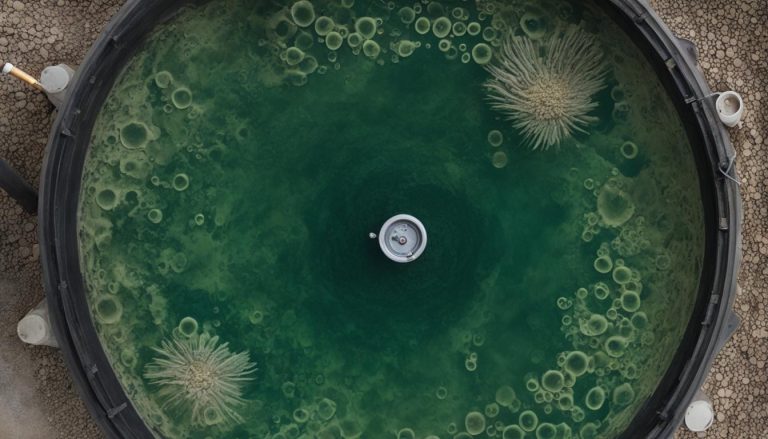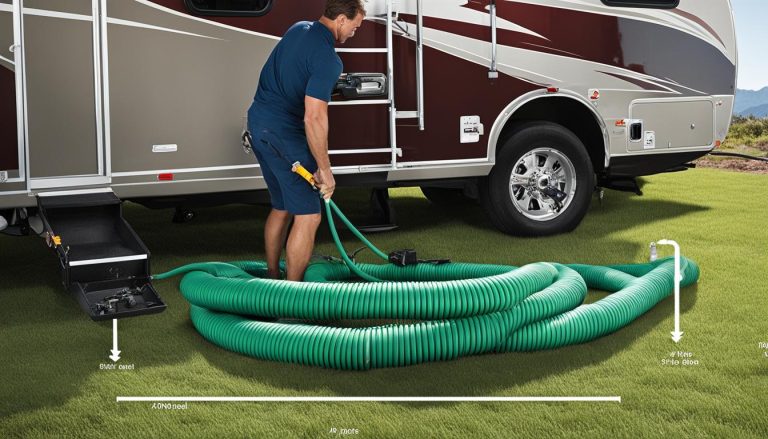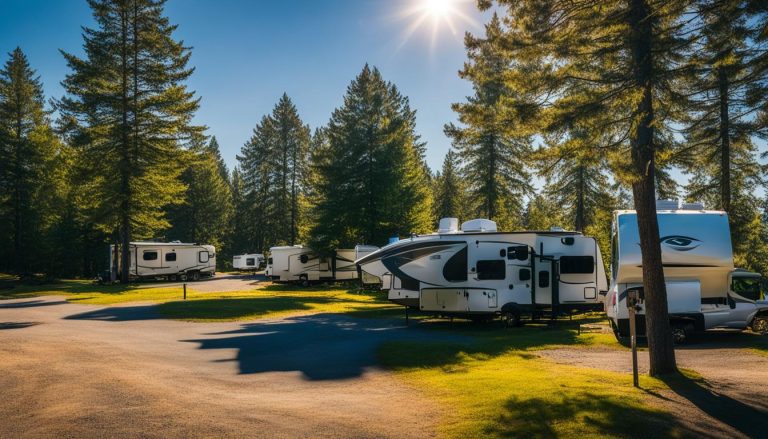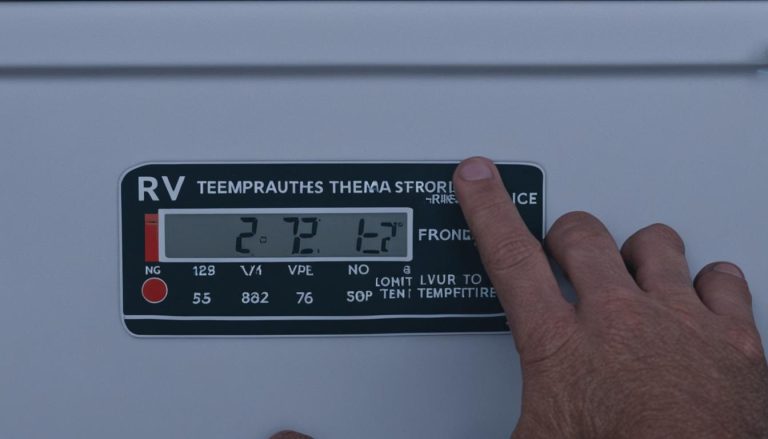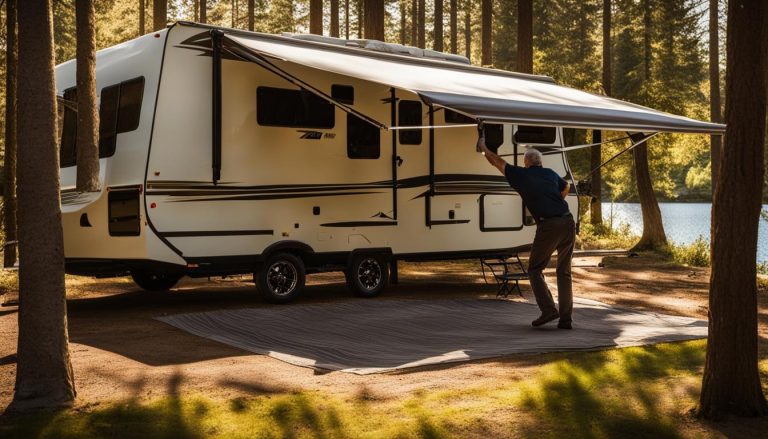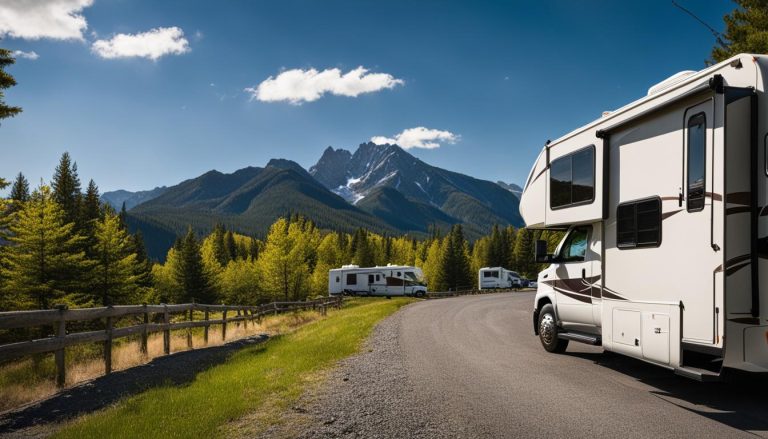RV Fresh Water Fill-Up Guide: Quick & Easy Tips
gorvlifestyle.com and its partners may earn a commission if you purchase a product through one of our links
Refilling the fresh water tank in your RV is an essential step to ensure you have access to clean water for drinking, cooking, and bathing during your camping trips. This guide will provide you with quick and easy tips on how to fill your RV with fresh water. Whether you are at a campground, a dump station, a travel center, a national forest, or using bottled water, we will cover all the options for refilling your RV’s fresh water tank.
Key Takeaways:
- Learn how to easily refill your RV’s fresh water tank
- Discover various options for refilling your tank, including using a faucet, pump, or gravity
- Find out where to locate potable water sources when on the road
- Explore alternative solutions in case potable water is not available
- Get tips for safe water handling and storage to prevent contamination
Refilling Your Water Tank Using a Faucet
One of the easiest and fastest ways to fill your RV’s fresh water tank is by using a water hookup with a faucet. To ensure the water you’re filling your tank with is safe for consumption, you will need a potable water hose specifically designed for drinking water.
- First, locate the water hookup at the campground or RV park.
- Connect one end of the potable water hose to the faucet and ensure it is securely attached.
- Attach the other end of the hose to the fresh water inlet on your RV.
- Open the faucet to allow the water to flow through the hose and into the tank.
- Monitor the tank’s fill level through the RV’s control panel or by visually inspecting the tank.
- Once the tank is full, turn off the faucet and disconnect the hose from both the faucet and the RV’s fresh water inlet.
Remember to only use potable water sources to refill your RV’s fresh water tank, as using non-potable water can lead to contamination and potential health risks. Additionally, make sure to regularly sanitize your fresh water tank and hose to maintain water quality.
Faucet Fill-Up Tips:
Tip #1: Use a hose with a length that allows for easy maneuverability and reach from the faucet to your RV’s fresh water inlet.
Tip #2: Prior to connecting the hose, run some water through it to flush out any debris or contaminants.
Tip #3: If the water pressure at the faucet is too high, consider using a water pressure regulator to protect your RV’s plumbing system.
By following these steps and using a potable water hose, you can easily and safely refill your RV’s fresh water tank using a faucet. This method is convenient, especially when staying at campgrounds or RV parks with water hookups readily available.
Most Common Places to Locate a Water Source
When you are on the road, there are several places where you can find potable water to refill your RV’s fresh water tank. Here are the most common places:
- Campgrounds: Many campgrounds offer water hookups or designated water filling stations where you can conveniently fill your RV’s fresh water tank.
- RV Parks: RV parks usually provide water hookups for each site, allowing you to easily refill your water tank without hassle.
- Travel Centers: Travel centers, such as truck stops and rest areas, often have water stations where you can access potable water for your RV.
- Dump Stations: Some dump stations also have potable water fill-up stations nearby, enabling you to both empty your waste tanks and refill your fresh water tank in one stop.
- National Forests: Certain national forests have designated water points where you can access potable water. Check with the forest service or park rangers for the locations.
Pro Tip: To ensure the water you are filling your RV’s fresh water tank with is potable and safe for consumption, look for “potable water” signs or ask park rangers, campground staff, or travel center attendants before using any water source.
If you’re unsure about the quality of the water source or cannot find a designated fill-up point, it’s recommended to use a reliable portable water filter or carry bottled water for drinking and cooking purposes.
Remember, it’s essential to prioritize the cleanliness and safety of the water you use in your RV to avoid any potential health risks. Regularly sanitize your fresh water tank and plumbing system to maintain optimal water quality.
With the availability of these common water sources, you can easily find potable water to refill your RV’s fresh water tank and enjoy a worry-free camping experience.

How to Refill Fresh Water Tank During Camping Using a Pump
When camping without access to a water hookup, using a pump is a convenient and efficient way to refill your RV’s fresh water tank. With a portable pump, you can easily and quickly transfer water from a source to your tank. Here is a step-by-step process to help you refill your fresh water tank using a pump:
- Gather the necessary equipment: To begin, make sure you have the following items:
- A portable water pump
- A potable water hose
- A water container or source
- Optional: a water filter
By following these steps, you can effectively refill your RV’s fresh water tank using a pump, even when a water hookup is unavailable. Remember to always use a potable water hose and consider using a water filter for added safety and water quality.
Please note: Before using any water source for refilling your fresh water tank, ensure it is potable and safe for consumption. If you are unsure about the quality of the water, consider using water purification tablets or a filtration system.
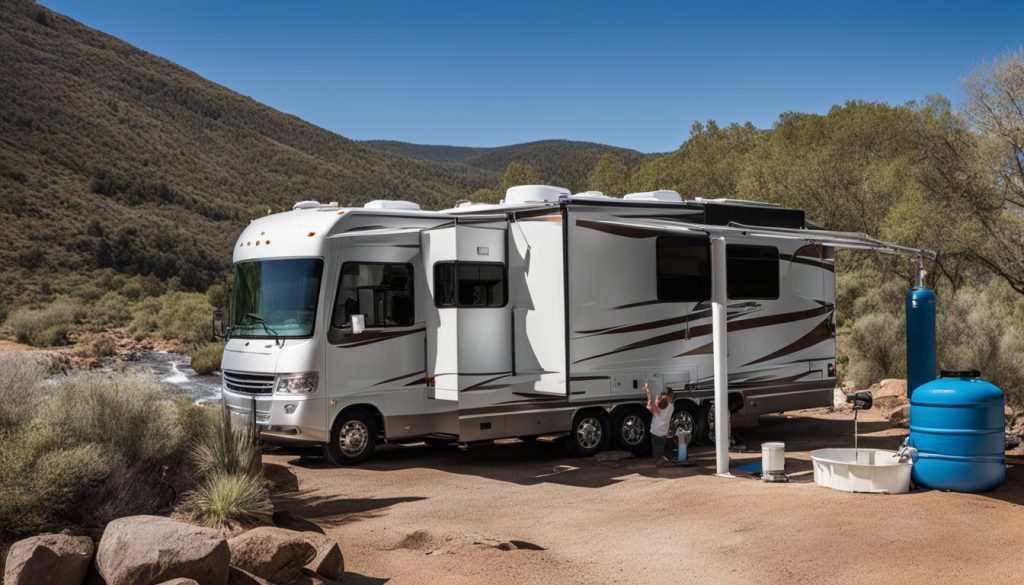
Refilling Your Water Tank Using Gravity
If you find yourself without access to a water hookup or a pump, don’t worry! You can still fill your RV’s fresh water tank using the power of gravity. This method is simple, effective, and doesn’t require a hose. Here’s how you can do it:
Gather Your Supplies
Before you begin, make sure you have the following supplies ready:
- A clean and sanitized container with a spout
- Enough water to fill your RV’s fresh water tank
- Assistance, if needed, to hold and pour the water
Find an Access Point
To use gravity to fill your RV’s fresh water tank, you need to locate a suitable access point. This can be a gravity fill port or an inlet specifically designed for filling the tank. Refer to your RV’s owner’s manual or consult the manufacturer to find the exact location of the access point.
Note: It’s important to use the designated access point to ensure proper water flow and prevent any damage to your RV’s water system.
Position Your Container
Place your clean and sanitized container with a spout on an elevated surface above the access point. This will create a natural flow of water using gravity. Ensure that the container is stable and secure to avoid any spills or accidents.
Pro tip: If possible, position the container on a stable platform or use a stand to make the pouring process easier and more convenient.
Pour the Water
Once you have positioned the container, carefully pour the water into the access point. Take your time and pour the water slowly to prevent any splashing or overflows. If you have assistance, they can help you hold and pour the water to make the process smoother.
Important: Ensure that you pour the water directly into the designated access point to avoid any cross-contamination or damage to other parts of the RV’s water system.
Monitor the Tank Level
As you pour the water, keep an eye on the tank level indicator or visually check the tank to ensure it doesn’t overflow. It’s crucial not to overfill the tank as it can lead to leaks and water damage. Once the tank is filled to the desired level, stop pouring.
Secure the Access Point
After filling the tank, securely close the access point to prevent any water leaks or spills. Make sure the cap or cover is tightened properly to maintain a tight seal.
Pro tip: It’s a good practice to regularly inspect and maintain the access point to ensure it remains in good condition and functioning properly.
And that’s it! By using gravity, you can effectively fill your RV’s fresh water tank without the need for a hose or external equipment. Remember to always use clean and potable water from a reliable source to ensure the safety and quality of your water supply.
| Advantages of Using Gravity to Refill Your RV’s Water Tank | Disadvantages of Using Gravity to Refill Your RV’s Water Tank |
|---|---|
|
|
What to Do If You Cannot Find Potable Water
In the unfortunate event that you are unable to find potable water for refilling your RV’s fresh water tank, don’t panic. There are a few solutions you can consider to ensure you have an alternative water source. Let’s explore some options:
1. Water Purification Tablets
If you have access to any water source, but you’re unsure of its quality, water purification tablets can be a lifesaver. These tablets are designed to kill harmful bacteria and viruses, making the water safe for consumption. Follow the instructions on the packaging for proper usage. Remember to always carry a sufficient supply of water purification tablets in your RV for emergencies.
2. Portable Water Filtration Systems
Investing in a portable water filtration system for your RV can provide you with peace of mind when potable water is scarce. These systems are designed to remove impurities and contaminants from various water sources, making them safe to drink. Look for a filtration system that suits your needs and has good reviews. A portable water filtration system can be a great asset during your camping adventures.
3. Rainwater Collection
In situations where there are no potable water sources nearby, consider collecting rainwater as an alternative. Rainwater is generally safe to use for basic needs such as washing dishes or flushing toilets. However, it is important to note that rainwater may contain pollutants, so it should not be used for drinking without proper purification or filtration. Use appropriate containers to collect rainwater and ensure they are clean to minimize contamination risks.
4. Emergency Water Storage
Preparing for emergencies by storing a sufficient supply of water is crucial for every RV owner. Consider allocating a designated space in your RV for emergency water storage. Use FDA-approved water storage containers that are specifically designed for long-term water storage. Rotate the water periodically to ensure freshness and use a water preservative to prevent the growth of bacteria or algae.
In addition to these solutions, it is important to stay informed about the water sources available at your destination before you embark on your RV adventure. Plan ahead and research the availability of potable water sources along your route or at your chosen campground. This will help you avoid any unpleasant surprises and ensure you have access to safe water for your RV.
Remember, keeping yourself and your loved ones hydrated with safe and clean water is crucial, especially when potable water is not readily available. By considering these alternative water sources and proper water handling techniques, you can navigate through any water scarcity situation with confidence.
| Solution | Advantages | Disadvantages |
|---|---|---|
| Water Purification Tablets | – Compact and portable – Easy to use – Affordable |
– May leave a chemical taste – Limited quantity per tablet |
| Portable Water Filtration Systems | – Removes contaminants – Provides higher water volume – Long-term investment |
– Requires regular maintenance – Higher upfront cost |
| Rainwater Collection | – Free water source – Environmentally friendly – Suitable for non-drinking needs |
– Can contain pollutants – Requires proper filtration/purification |
| Emergency Water Storage | – Preparedness for emergencies – Long-term water supply – Convenient and accessible |
– Requires regular rotation – Limited storage capacity |
Tips for Safe Water Handling and Storage
When refilling your RV’s fresh water tank, it’s important to practice safe water handling and storage to prevent contamination. Follow these tips to ensure the safety of your water supply:
- Use a dedicated potable water hose: Invest in a hose specifically designed for drinking water to prevent any potential contaminants from leaching into your RV’s fresh water tank.
- Clean and sanitize your water tank: Regularly clean and sanitize your RV’s fresh water tank to eliminate any bacteria or mold buildup. Refer to your RV owner’s manual for specific instructions on how to properly clean and sanitize your water tank.
- Monitor water quality: Periodically test the quality of your RV’s fresh water to ensure it is safe for consumption. Consider purchasing water testing kits that can detect harmful substances or contaminants.
- Keep your RV’s water system sealed: To avoid introducing external contaminants into your RV’s fresh water tank, always keep the water system sealed when not in use. This includes securely closing all faucets, showerheads, and valves.
- Store water in clean containers: If you need to store additional water in containers outside of your RV’s fresh water tank, make sure the containers are clean and designated for potable water use. Avoid using containers that have held chemicals or other non-potable substances.
In addition to these tips, it’s crucial to follow any manufacturer recommendations or guidelines specific to your RV’s water system. By practicing safe water handling and storage, you can enjoy a worry-free camping experience with a clean and reliable water supply.
Quote:
“Proper water handling and storage are essential for maintaining the freshness and safety of your RV’s water supply.” – Camping Enthusiast
| Tips for Safe Water Handling and Storage |
|---|
| 1. Use a dedicated potable water hose |
| 2. Clean and sanitize your water tank |
| 3. Monitor water quality |
| 4. Keep your RV’s water system sealed |
| 5. Store water in clean containers |
Conclusion
Refilling your RV’s fresh water tank is crucial for ensuring a clean water supply during your camping adventures. By following the tips and methods we’ve provided in this guide, you can easily and safely refill your tank in a variety of situations. Remember to prioritize the safety of your water supply by using potable water sources, practicing proper water handling and storage techniques, and regularly sanitizing your fresh water tank.
By taking these precautions, you can embark on your RV journey with peace of mind, knowing that you have a sufficient supply of fresh water. Whether you’re exploring national parks, camping at remote sites, or enjoying the amenities of a campground, having access to clean water is essential for a comfortable and enjoyable trip.
So, go ahead and make use of the faucet, pump, or gravity fill method to refill your RV’s fresh water tank. Be resourceful in finding potable water sources when needed and always prioritize the safety of your water supply. With these final thoughts in mind, you’re now equipped with the knowledge and techniques to ensure a worry-free adventure and a reliable source of fresh water in your RV.
Happy camping!
FAQ
How do I fill my RV with fresh water?
There are several methods for filling your RV’s fresh water tank. You can use a water hookup with a faucet, locate potable water sources, use a pump, or even rely on gravity to fill your tank. We will provide you with step-by-step instructions for each method.
Can I fill my RV’s fresh water tank using a faucet?
Absolutely! One of the easiest and fastest ways to fill your RV’s fresh water tank is by using a water hookup with a faucet. Make sure to have a potable water hose specifically designed for drinking water and follow the provided steps in our guide.
Where can I find potable water to refill my RV’s fresh water tank?
When you are on the road, you can find potable water at various places. Some common locations include campgrounds, dump stations, travel centers, and even national forests. We’ll provide you with a detailed list of the most common places to locate a water source for your RV.
How can I refill my RV’s fresh water tank during camping without a water hookup?
If you are camping without access to a water hookup, you can still refill your RV’s fresh water tank using a pump. Our guide will walk you through the process and help you choose a portable pump for easy filling.
Is it possible to fill my RV’s fresh water tank using gravity?
Yes! If you don’t have access to a water hookup or a pump, you can use gravity to help fill your RV’s fresh water tank. We will provide you with step-by-step instructions on how to easily accomplish this.
What should I do if I cannot find potable water to refill my RV’s fresh water tank?
Don’t worry! In the event that you cannot find potable water for refilling your RV’s fresh water tank, there are a few solutions you can consider. Our guide will outline these alternatives and help you find emergency water sources for your RV.
How can I ensure safe water handling and storage while refilling my RV’s fresh water tank?
Safety is crucial when it comes to water handling and storage. We will provide you with important tips to follow, including using potable water sources, practicing proper water handling techniques, and regularly sanitizing your fresh water tank.
Why is it important to refill my RV’s fresh water tank?
Refilling your RV’s fresh water tank is important to ensure you have access to clean water while camping. By following the tips and methods outlined in our guide, you can easily and safely refill your tank in various situations, guaranteeing a worry-free adventure.

